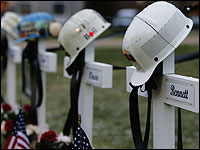 Today marks the first anniversary of the Sago Mine Disaster which killed twelve West Virginia miners and launched a year that would see the number of deaths in the nation's coal mines climb from 22 in 2005 to 47 in 2006. Sago and subsequent incidents led to the passage of mine safety legislation in the US Congress and the states of West Virginia and Kentucky.
Today marks the first anniversary of the Sago Mine Disaster which killed twelve West Virginia miners and launched a year that would see the number of deaths in the nation's coal mines climb from 22 in 2005 to 47 in 2006. Sago and subsequent incidents led to the passage of mine safety legislation in the US Congress and the states of West Virginia and Kentucky.But conditions aren't improving fast enough:
Many of the safety measures that state legislatures and the Congress rushed to adopt to protect the 46,000 people working in the nation's underground coal mines after the Sago Mine explosion a year ago today have yet to take effect.And just today, Ken Ward at the Charleston Gazette notes that MSHA knew for ten years that the foam blocks allowed by the Mine Safety and Health Administration to to seal off abandoned areas of mines were not strong enough to withstand the blast forces that could be anticipated.
There are still no rescue chambers or wireless tracking and communications equipment in the country's 606 underground coal mines, and it is unlikely that there will be until federal requirements kick in more than two years from now.
Hundreds of emergency air packs that are to be stored underground - currently required by law - are on back order and will take months to deliver.
"You can't walk over and flip the switch and change it all in a year," said James M. Dean, who spent eight months as West Virginia's mine safety chief after the Sago Mine explosion. "The negative is, it's not happening fast enough."
One year ago today, an explosion tore through International Coal Group’s Sago Mine in Upshur County. Twelve miners died.More information on the 2006 mine disasters here.
So far, two state investigations have blamed lightning. Neither probe has figured out how lightning got into the mine. But both have found that the explosion was far stronger than the 20-psi standard mine seals were required to meet.
Five months after Sago, then-acting MSHA chief David Dye issued a temporary moratorium on new seals built under the agency’s 20-psi standard. State officials in West Virginia took similar action.
But the Sago disaster might not have happened if regulators and the coal industry had heeded the warnings from Oak Grove, and from a series of other lightning-induced explosions in the U.S. and abroad dating back more than 30 years, federal and state investigators have learned.
Today, thousands of underground miners across the coalfields work alongside foam-block seals that experts now acknowledge don’t meet the “explosion proof” test required by the 1969 federal mine safety law.
So far, no one has a plan to protect these miners.